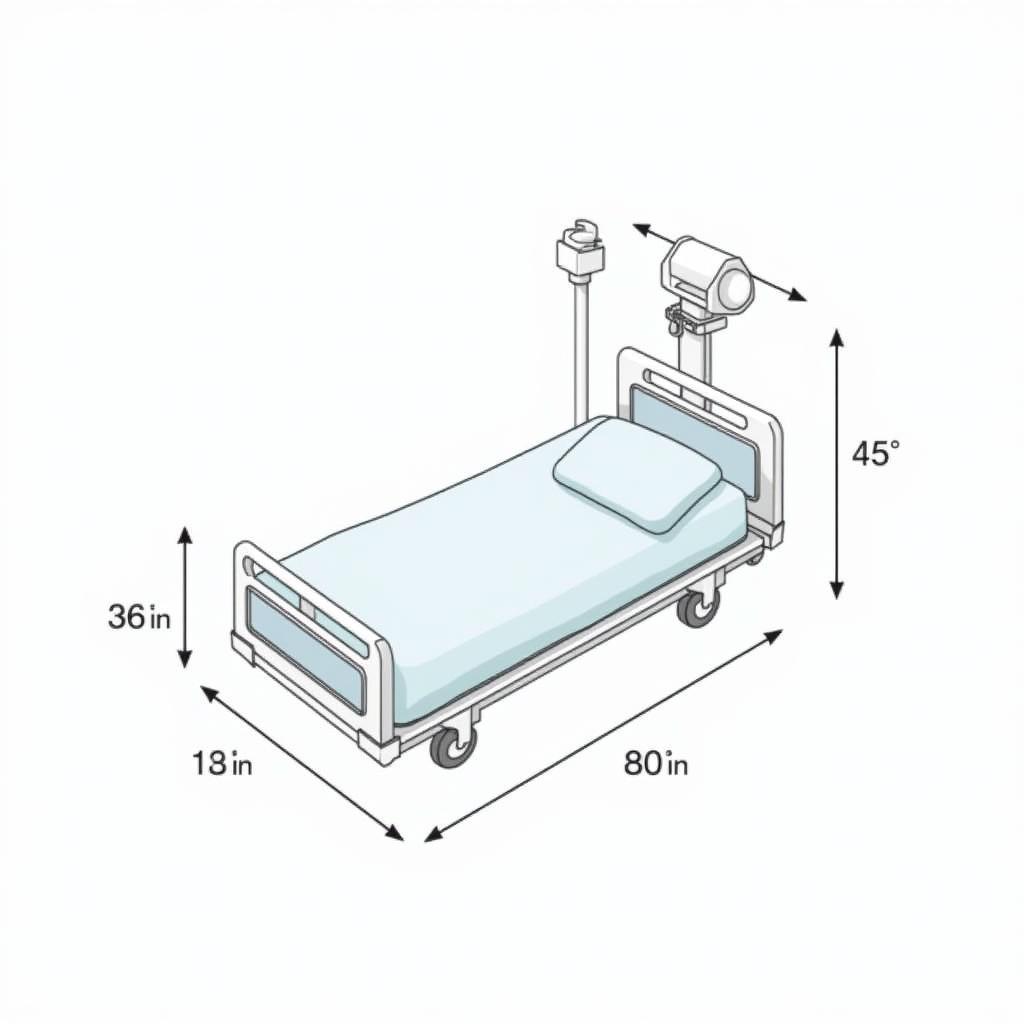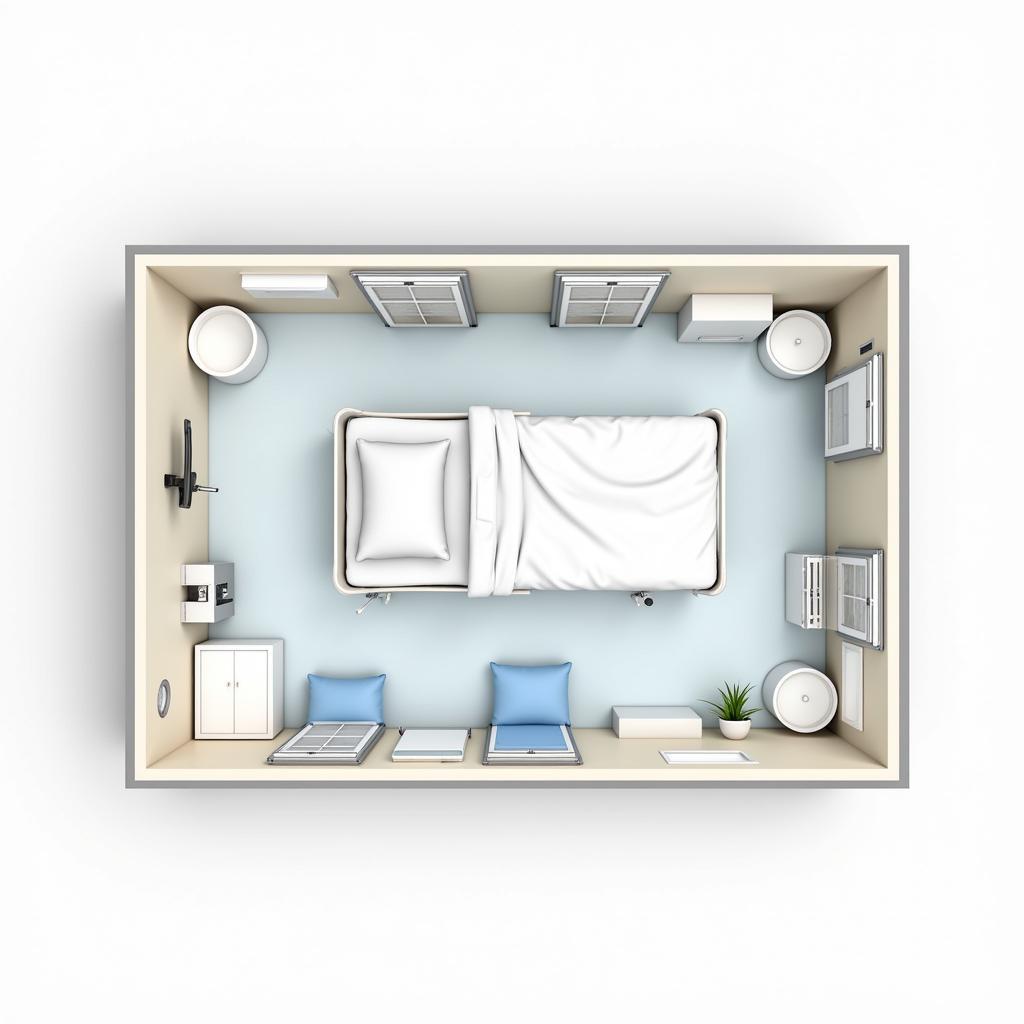Understanding Hospital Bed Size Dimensions is crucial for both healthcare professionals and individuals seeking the right bed for home care. Whether you’re outfitting a new hospital wing or setting up a comfortable recovery space at home, knowing the standard and specialized dimensions can make all the difference in patient comfort and safety.
Choosing the right hospital bed goes beyond just length and width. It involves considering the patient’s needs, the available space, and the features required for optimal care. This guide will delve into the standard hospital bed size dimensions, explore variations for bariatric and pediatric patients, and discuss the importance of these measurements in creating a therapeutic environment.
Standard Hospital Bed Dimensions: What to Expect
The typical hospital bed size dimensions are approximately 36 inches wide and 80 inches long. This size accommodates most adult patients comfortably while allowing sufficient space for medical equipment and caregiver access. It’s important to note that these are average dimensions, and slight variations may exist between manufacturers. However, understanding the standard size provides a valuable baseline. A halo bed rail for hospital bed can be added for increased safety.
 Standard Hospital Bed Dimensions Illustration
Standard Hospital Bed Dimensions Illustration
Many beds are also adjustable in height, allowing caregivers to position the bed at a comfortable working level and facilitating safe patient transfers. This adjustable height feature is particularly essential for preventing back strain in caregivers and minimizing the risk of falls for patients.
Bariatric and Pediatric Hospital Bed Size Dimensions
While the standard size caters to most adults, specialized dimensions are available for specific patient populations, such as bariatric and pediatric patients. Bariatric beds are designed to support heavier individuals and are typically wider and more robustly constructed than standard hospital beds. Their dimensions can vary but are generally wider than standard models, often exceeding 42 inches in width.
Pediatric hospital beds, on the other hand, are smaller and designed to accommodate the size and developmental needs of children. These beds are typically shorter and narrower than adult beds, prioritizing safety and age-appropriate features. For patients seeking added comfort, considering padding for hospital bed is a valuable option.
Why Hospital Bed Size Dimensions Matter
Hospital bed size dimensions are critical for several reasons. Properly sized beds promote patient comfort and safety, reduce the risk of pressure sores, and facilitate effective care. Choosing the appropriate dimensions is particularly important for patients with mobility issues or those who spend extended periods in bed. A comfortable cotton hospital blanket further enhances patient well-being.
What are the typical dimensions of a hospital bed?
The standard hospital bed is usually 36 inches wide and 80 inches long.
Why are bariatric bed dimensions different?
Bariatric beds are wider and stronger to accommodate heavier patients safely.
How do pediatric bed dimensions enhance safety?
Smaller dimensions in pediatric beds help prevent falls and address the specific needs of children.
Beyond the Basics: Considering Additional Factors
Understanding hospital bed size dimensions is just the first step. Other important factors include mattress selection, bed features (such as adjustable height and side rails), and the overall room layout. A well-planned space, incorporating the appropriate bed size and accessories, contributes significantly to patient well-being and recovery. Consider a hospital gurnee bed for its versatile features.
 Hospital Bed Room Layout Example
Hospital Bed Room Layout Example
Conclusion: Finding the Perfect Fit
Choosing the right hospital bed involves carefully considering the patient’s needs and the available space. Understanding hospital bed size dimensions is fundamental to this process. Whether you’re looking for a standard, bariatric, or pediatric bed, finding the perfect fit ensures optimal comfort, safety, and ultimately, a positive healing experience. You might also want to explore the benefits of a hospital bed fully electric for enhanced patient care.
Dr. Amelia Carter, Chief of Nursing at San Jose Hospital: “Properly sized hospital beds are essential for patient comfort and effective care. We prioritize selecting beds that meet the individual needs of our patients, promoting a positive healing environment.”
Dr. David Lee, Medical Director at San Jose Hospital: “Considering the dimensions of the bed within the context of the overall room layout is crucial for optimizing patient safety and caregiver access.”
Nurse Practitioner Maria Rodriguez: “Choosing the right hospital bed size can significantly impact a patient’s recovery process. It’s important to consider factors like mobility and the need for specialized features.”
 Different Hospital Bed Types for Various Needs
Different Hospital Bed Types for Various Needs
FAQ
- What is the standard hospital bed width? (Typically 36 inches)
- How long is a standard hospital bed? (Usually 80 inches)
- What are bariatric hospital beds? (Beds designed for heavier patients)
- Why are pediatric beds smaller? (For child safety and comfort)
- What other factors should I consider besides size? (Mattress, features, room layout)
- Where can I find more information about hospital beds? (Consult with medical professionals or specialized suppliers)
- Are there adjustable hospital beds? (Yes, many offer adjustable height and other features.)
For support, contact us at Phone Number: 02437655121, Email: [email protected], or visit us at 298 Cau Dien Street, Minh Khai Ward, Bac Tu Liem District, Hanoi, Vietnam. Our customer service team is available 24/7.